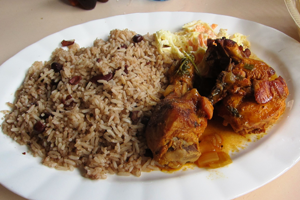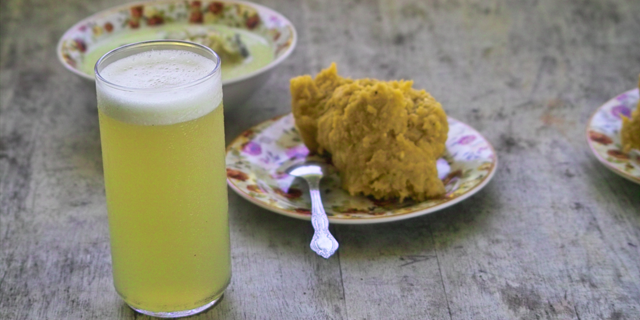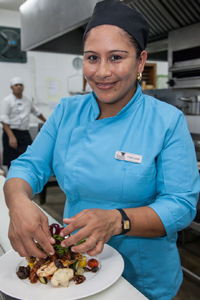“She’s from one race and I’m from another,” Elsy says bluntly. “I don’t like Hudut, I wouldn’t eat it, and she loves it.”
“But why not,” I ask. “It sounds delicious.”
“Yes,” she agrees. “I hear it’s very good.”
I hold my breath and wait for Denise to get offended. She has just described the main dish for the holiday Settlement Day, celebrated by the Garifuna in southern Belize where she’s from. But she only nods her head in agreement and I shake mine in amazement.
We’re sitting in the Chaa Creek lodge dining room in western Belize. Denise is the color of dark chocolate with a round face and full lips. Elsy has skin like cocoa, a 50/50 Maya-mestizo mix. Mario, the lodge’s Guatemalan chef, is the color of burnt milk with the features of a Spaniard. We’ve been talking food for about 30 minutes when Elsy makes her statement. I have a sneaking suspcion that Belize’s cuisine is not as ethinically black and white as she thinks (fried corn tortillas with coconut oil, anyone?) but there are some serious regional differences in how Belizeans cook and what they like.
The Maya, with their corn and beans, have been in Belize since the second millennium BC. Even though the majority of the original population died from disease and war when foreign settlers came in 1683, another wave of Maya came into the country from Mexico in the 1840s to escape the Caste War and from Guatemala during the 19th century. Then there are the English, who built their settlements to log the forests and brought African slaves across the ocean to do the heavy lifting.
The Garifuna of southern Belize, also of African-descent, are believed to be the survivors of a slave ship shipwreck and landed on St. Vincent Island as free men. They came to Belize in 1802 from St. Vincent after their war with the English for control of the island. Oh, and of course Latin America’s ever-present Spanish, who “discovered” Belize as part of their conquest, but passed it over in favor of places like the gold-rich Yucatan peninsula in Mexico. Quite a mix.
It’s understandable then that on my trip around the country there were a lot of different answers to the same basic question: What do Belizeans eat?
Next, a look at how Belizeans spend their holidays…
[pagebreak]From the southern part of Belize, where African and Caribbean roots are the strongest, comes the tradition of cooking with coconut oil and coconut milk. On Settlement Day, the Garifuna’s day to celebrate their ancestors’ arrival to the country, families boil fish (any kind of white fish Denise explains) with coconut milk, hot chiles, cilantro, a little black pepper, and some allspice until the mixture thickens down into a soup. Next they boil both unripe and ripe plantains (one salty and the other sweet) until soft and mash them together.
“Then you use your fingers and take a little pitch of plantains and you dip it in the milk and that’s how you eat it,” says Denise. “You don’t need a spoon or fork.” It’s called hudut (pictured above) and her mouth is watering just describing about it. Coconut oil is also used to cook rice for rice and beans, and fish and seafood are main staples of the southern diet.
Elsy’s family in the North, makes thick corn tamales, steamed banana leaves filled with a mixture of tomato-based salsa, chicken, and ground corn. They also make bollos, the tamale‘s first cousin, made in the same way, but with a thicker dough and often, around New Years, with espelón beans.
I’m starting to think there’s not much common ground in Belizean cuisine when someone mentions black cake. Almost simultaneously all six eyes roll back in their heads with delight. Finally, something we can all agree on! Black cake is a Belize Christmas tradition, that’s preparation starts much earlier. Mario says that people are probably already buying their ingredients.
This cake is similar to the American fruitcake and after baking is soaked in rum for a minimum of 20 days. “When it’s finally ready on December 24th, a few slices and a glass of rompope (Belizean eggnog) and you might never see Christmas,” says Mario.
The list of ingredients changes depending on who you talk to. The cake can include molasses, allspice, vanilla, dried fruits, flour, cornstarch, and “even stout beer,” says Lucia (right), another chef I talked with on the northern coast of Belize. She couldn’t quite remember the whole recipe when I asked for it, but knew that it included “a lot” of rum.
Next, how to spend the holidays in Belize…
[pagebreak]Lucia works at a resort in Ambergris Caye about 11 miles by boat from the town of San Pedro. She and her kitchen crew are all from the area. All day long they cook international food for their guests and were happy to talk home cooking when I snuck into the kitchen.

One thing these coastal cooks aren’t that interested in is seafood. “We cook seafood here everyday,” says Daniel, one of the crew. “We’re tired of seafood.” Instead they wax poetic about baked chicken and rice and beans, or beans and rice – depending on how you cook them. Turns out that “rice and beans” are when each is cooked separately and “beans and rice” are when they are cooked together. Confusing? I should say so. Sunday dinner, a national institution, is comprised of just those elements – baked chicken, beans and rice (or rice and beans), and potatoes or plantains. Meat here is often prepared with “jerk” spices, a mix that includes black pepper, paprika, allspice, cinnamon, and salt.
When I ask about the holidays, everybody agrees on Christmas protocol. The 24th of December is for being at home with family and eating and drinking (and debuting your black cake) and the 25th is for visiting friends … and eating and drinking and sampling other peoples’ black cake.
“You have to make sure you have lots of soda, beer, and food,” says Elsy. “You never know who’s going to stop by. You should come spend a Christmas in Belize, it’s lovely.”



![Making Mealtime Matter with La Familia: Easy Sofrito [Video]](https://thelatinkitchen.com/wp-content/uploads/2015/10/sofrito-shutterstock__0-500x383.jpg)
![Easy Latin Smoothies: Goji Berry Smoothie [Video]](https://thelatinkitchen.com/wp-content/uploads/2015/12/goji_berry-shutterstock_-500x383.jpg)
















![Fun and Fast Recipes: Fiesta Cabbage Salad [Video]](https://thelatinkitchen.com/wp-content/uploads/2015/11/fiesta_cabbage_slaw-shutterstock_-500x383.jpg)









